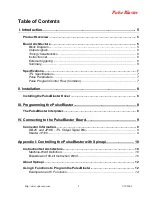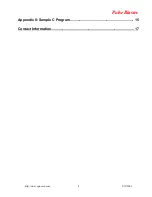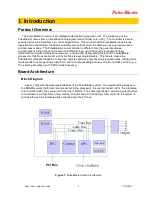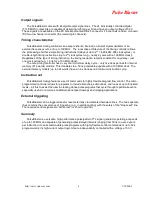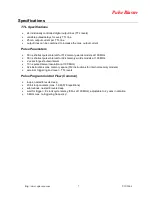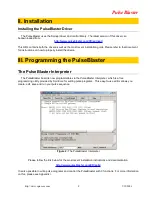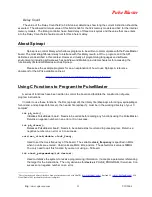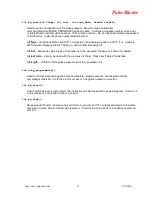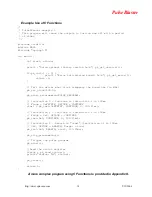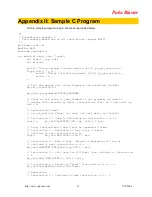
PulseBlaster
Output Pattern and Control Word
Please refer to Table 1 for output pattern and control bit assignments of the 24-bit output/control word.
Bit
#
Bit #
Function
23
Header JP300 pin 1
11
Output Connector DB25 pin 5
22
Header JP300 pin 3
10
Output Connector DB25 pin 18
21
Header JP300 pin 5
9
Output Connector DB25 pin 19
20
Header JP300 pin 7
8
Output Connector DB25 pin 7
19
Header JP300 pin 9
7
Output Connector DB25 pin 8
18
Header JP300 pin 11
6
Output Connector DB25 pin 21
17
Header JP300 pin 13
5
Output Connector DB25 pin 22
16
Header JP300 pin 15
4
Output Connector DB25 pin 10
15
Output Connector DB25 pin 2
3
Output Connector DB25 pin 11
14
Output Connector DB25 pin 15
2
Output Connector DB25 pin 24
13
Output Connector DB25 pin 16
1
Output Connector DB25 pin 25
12
Output Connector DB25 pin 4
0
Output Connector DB25 pin 13
Table 1:
Output Pattern and Control Word Bits
Data Field and Op Code
Please refer to Table 2 for information on the available operational codes (OpCode) and the associated
data field functions (the data field's function is dependent on the Op Code)
Op Code #
Inst
Inst_data
Function
0
CONTINUE
Ignored
Program execution continues to next
instruction
1
STOP
Ignored
Stop execution of program (*Note all TTL
values remain from previous instruction, and
analog outputs turn off)
2
LOOP
Number of desired loops. This
value must be greater than or
equal to 1.
Specify beginning of a loop. Execution
continues to next instruction. Data used to
specify number of loops
3
END_LOOP
Address of beginning of loop
Specify end of a loop. Execution returns to
begging of loop and decrements loop
counter.
4
JSR
Address of first subroutine
instruction
Program execution jumps to beginning of a
subroutine
5
RTS
Ignored
Program execution returns to instruction
after JSR was called
6
BRANCH
Address of next instruction
Program execution continues at specified
instruction
7
LONG_DELAY
Number of desired loops. This
value must be greater than or
equal to 2.
For long interval instructions. Data field
specifies a multiplier of the delay field.
Execution continues to next instruction
8
WAIT
Ignored
Program execution stops and waits for
software or hardware trigger. Execution
continues to next instruction after receipt of
trigger. The latency is equal to the delay
value entered in the WAIT instruction line
plus a fixed delay of 6 clock cycles.
Table 2:
Op Code and Data Field Description
http://www.spincore.com
5/19/2006
11



